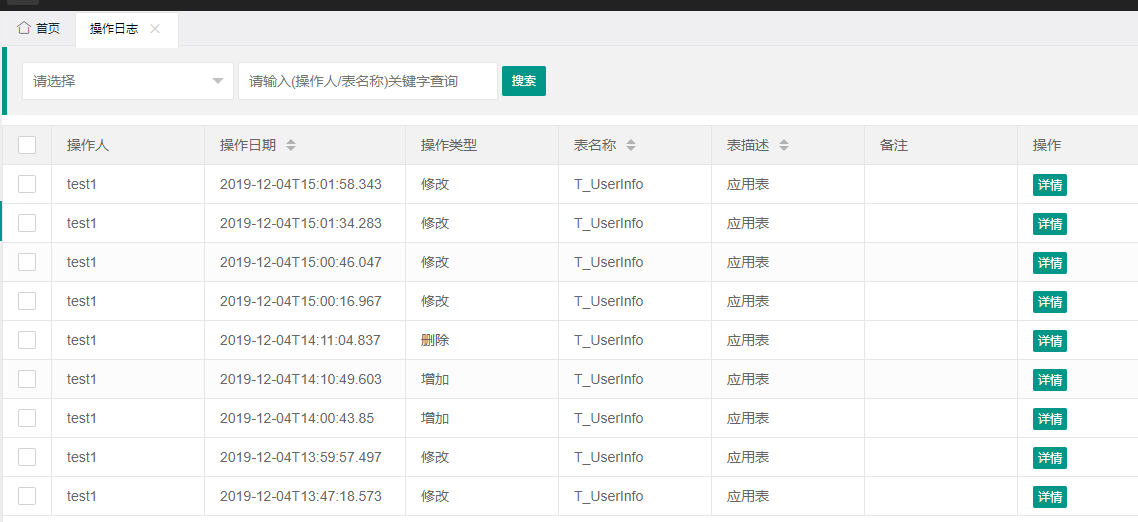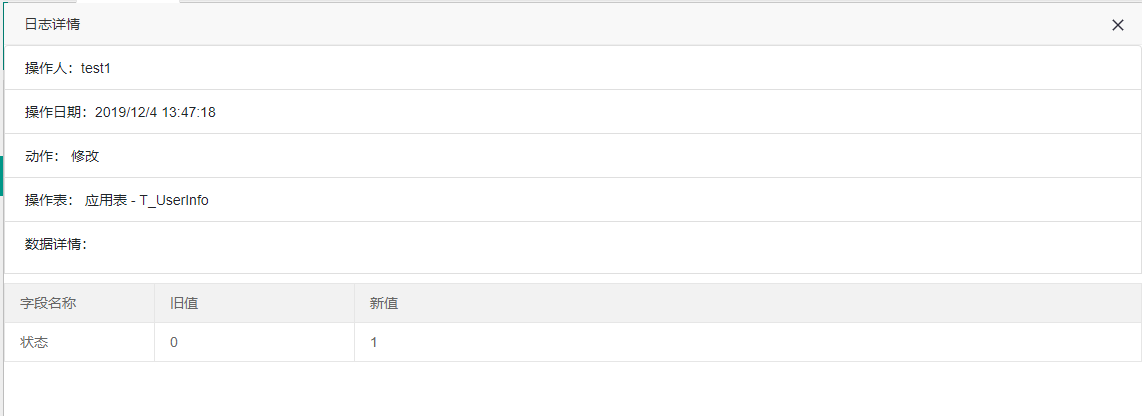/// <summary>
/// operation log associated /// </ Summary> /// <typeParam name = "T"> </ typeParam> public class the LogManager <T> WHERE T: new new () { static Database DB = new new Database (the DBHelper. the GetConnection ()); /// <Summary> /// logging /// </ Summary> /// <param name = "operationUser"> the user currently logged </ param> /// <param name = "operateType "> operation type </ param> /// <param name =" newMd "> </ param> /// <param name = "oldMd"> when new operation, which may be empty</param> public void AddLog(string operationUser, OperateType operateType, T newMd, T oldMd) { T_OperateLog log = new T_OperateLog(); List<LogDetail> logDetailList = new List<LogDetail>(); //取得m的Type实例 Type t = newMd.GetType(); log.OperateUser = operationUser; log.OperateType = operateType; log.TblName = typeof(T).Name; log.CreateDate = DateTime.Now; log.TblNameDesc = ((DescriptionAttribute)System.Attribute.GetCustomAttributes(typeof(T))[0]).Description; using (var db = new Database(AppConfig.DefaultConnectionString, "SqlServer")) { int logPKeyVal = 0; var logPKey = db.Insert("T_OperateLog", "LogId", log); if (logPKey != null) { logPKeyVal = Convert.ToInt32(logPKey); } switch (operateType) { case OperateType.Add: AddDelOperation(operateType, t, logPKeyVal, newMd); break; case OperateType.Edit: EditOperation(t, logPKeyVal, oldMd, newMd); break; case OperateType.Del: AddDelOperation(operateType, t, logPKeyVal, newMd); break; case OperateType.Query: //EditOperation (T, logPKeyVal, oldMd, newMd); BREAK ; } } } /// <Summary> /// editing operation /// </ Summary> /// <param name = "T"> </ param> / // <param name = "logKey"> </ param> /// <param name = "oldMd"> </ param> /// <param name = "newMd"> </ param> Private void EditOperation (the Type T , int logKey, oldMd T, T newMd) { // obtain class attribute names and attribute values and obtain the Description the foreach (PropertyInfo property in T.GetProperties ()) // Loop through { LogDetail logDetail = new LogDetail(); string propertyDsc = string.Empty; var oldObj = oldMd.GetType().GetProperty(property.Name).GetValue(oldMd, null); var oldVal = oldObj == null ? "" : oldObj.ToString(); var newObj = newMd.GetType().GetProperty(property.Name).GetValue(newMd, null); var newVal = newObj == null ? "" : newObj.ToString(); if (oldVal != newVal) { logDetail.LogId = logKey; logDetail.ColumnName = property.Name; logDetail.ColumnDesc = GetCustomerDesc(property); logDetail.OldVal = oldVal; logDetail.NewVal = newVal; logDetail.CreateDate = DateTime.Now; using (var db = new Database(AppConfig.DefaultConnectionString, "SqlServer")) { db.Insert("T_LogDetail", "ID", logDetail); } } } } /// <summary> /// 新增/删除操作 /// </summary> /// <param name="operateType"></param> /// <param name="t"></param> /// <param name="logKey"></param> /// <param name="newMd"></param> private void AddDelOperation(OperateType operateType, Type t, int logKey, T newMd) { // property name acquired class and getting a property value and the Description the foreach (PropertyInfo Property in t.GetProperties ()) // Loop through { LogDetail logdetail = new new LogDetail (); String propertyDsc = String .Empty; var newobj = newMd.GetType () .GetProperty (property.Name) .getValue (newMd, null ); var newVal newobj = == null ? "" : newObj.ToString (); logDetail.LogId = logKey; logDetail.ColumnName= property.Name; logDetail.ColumnDesc = GetCustomerDesc(property); logDetail.OldVal = operateType == OperateType.Del ? newVal : ""; logDetail.NewVal = operateType == OperateType.Add ? newVal : ""; logDetail.CreateDate = DateTime.Now; using (var db = new Database(AppConfig.DefaultConnectionString, "SqlServer")) { db.Insert("T_LogDetail", "ID", logDetail); } } } /// <summary> /// 获取Model的DescriptionAttribute /// </summary> /// <param name="property"></param> /// <returns></returns> public string GetCustomerDesc(PropertyInfo property) { string propertyDsc = string.Empty; var arrProDesc = property.GetCustomAttributes(typeof(DescriptionAttribute), true); if (arrProDesc != null && arrProDesc.Length > 0) { propertyDsc = ((DescriptionAttribute)arrProDesc[0]).Description; } return propertyDsc; } }
Call the method:
LogManager<T_UserInfo> log = new LogManager<T_UserInfo>();
log.AddLog(currentUserName, OperateType.Del, appUser, null);
enumerate:
enum OperateType public
{
/// <Summary>
/// increase
/// </ Summary>
[the Description ( "increase")]
the Add =. 1,
/// <Summary>
/// modify
/// </ Summary>
[the Description ( "modify")]
the Edit = 2,
/// <Summary>
/// Remove
/// </ Summary>
[the Description ( "Delete")]
Del =. 3,
/// <Summary>
/// Query
/// </ Summary>
[the Description ( "query")]
Query =. 4
}
Built table:
public class T_OperateLog
{
public T_OperateLog()
{
CreateDate = DateTime.Now;
}
public int LogId { get; set; }
/// <summary>
/// 操作者
/// </summary>
[MaxLength(50)]
public string OperateUser { get; set; }
/// <Summary>
/// operation type
/// </ Summary>
public OperateType OperateType {GET; SET;}
public string TblName { get; set; }
public string TblNameDesc { get; set; }
/// <summary>
/// 操作时间
/// </summary>
public DateTime CreateDate { get; set; }
/// <summary>
/// 备注
/// </summary>
[MaxLength(500)]
public string Remark { get; set; }
}
public class LogDetail
{
public LogDetail()
{
CreateDate = DateTime.Now;
}
public int ID { get; set; }
public int LogId { get; set; }
public string ColumnName { get; set; }
public string ColumnDesc { get; set; }
public string OldVal { get; set; }
public string NewVal { get; set; }
public DateTime CreateDate { get; set; }
}
effect:

